Influence of the Distribution of Pits on the Friction and Wear Performance of Textured Rolling Bearings under Starved Lubrication
Abstract
1. Introduction
2. Materials, Modeling and Setup
2.1. Materials
2.2. Modeling
2.3. Experimental Setup and Methodology
2.4. Simulation Modeling and Setup
3. Results of Experiments and Simulations
3.1. COFs
3.2. Mass Losses and Worn Raceways
3.3. Surface Equivalent Stresses
4. Discussion
4.1. Effect of CFIAs on the Friction and Wear Properties
4.2. Effect of the Location of Pits on Friction and Wear Properties
4.3. Influence Mechanism for Partially Distributed Patterns on the Friction and Wear Properties of Rolling Bearings under Starved Lubrication
- (1)
- When a rolling bearing keeps rotating under lubricated conditions, the lubricant will move on the raceways of washers under the driving of centrifugal force, whether textured or smooth [39]. When there is no oil added during the whole test under starved lubrication, the bearing will gradually enter the dry wear stage with the gradual consumption of lubricant. The storage capacities of the pits in textured patterns can cause “secondary lubrication” of the contact surfaces, which is the reason why the friction drag in almost all textured patterns becomes more reduced than the result for the SR, especially when the CFIA is 1.5°. During the transition process from boundary lubrication to the dry condition, nylon powder is gradually generated for the gradual direct contact between metal rollers and the holes of a cage. Owing to the “centrifugal throwing effect” during fast rotating, wear debris (both metal and nylon) transfers onto the raceway, which will cause a transition from two-body friction to three-body friction. As a result, the friction drag and temperature in the “washers-cage-rollers” contact system increase gradually, and the rollers may even become stuck by debris [4,31,32,33,34,35,36]. Due to the collection and storage capacity of pits, the metal debris and nylon powder retained on the textured contact surface is quite less than the conditions of smooth bearings. However, the nylon transferring film is still gradually formed for high-contact flash temperature and concentrated on the positions, as shown in Figure 6. Finally, the friction-reducing performance of the bearing will gradually decrease but its anti-wear may be enhanced because of the well-tribological and self-lubricating properties of nylon (see Figure 4 and Figure 5).
- (2)
- Partially distributed patterns may decrease the surface equivalent stresses of textured contact surfaces, especially the two stress peaks [32]. This will bring more advantages than disadvantages for the tribological behavior of rolling bearings and is also the reason why the friction and wear properties of TS are improved, whether the CFIA is 1.5° or 2.0°. Although the inside-distributed pits can collect and store wear debris, a sudden change from the textured region to the smooth region can seriously break the transfer of debris. This is the reason why the tribological properties of IS-3/4 are so poor when the CFIA is 1.5°. This is also the reason for the excellent tribological performance of outside-distributed patterns (OS-1/4, OS-1/2 and OS-3/4) when the CFIA is 1.5°.
- (3)
- CFIA directly affects the area density of textured patterns and the number of pits. A larger area density and more pits mean a large capacity of the textured contact surface. Consequently, the stored oil in the earlier stage and the debris storage capacity in the later stage will be significantly enhanced, which is why, when the CFIA is 1.5°, the tribological behavior of bearings is obviously better than that when the CFIA is 2.0°. However, more pits also imply a reduced ECA. Based on the classical Coulomb formula, the friction will increase, and the COF is also bound to increase. The fatigue peeling of material along the edges of pits will become serious for the stress concentration in this condition (see Figure 9). Eventually, the metal debris generated may leave the “washers-cage-rollers” contact system or be melted with the nylon transferring film. What is left in the system will cause deterioration in the tribological performance of rolling bearings, as observed for IS-1/2 and IS-3/4 [4,7,8,31,32,33,34,35,36].
- (4)
- Different from the conditions of partially textured patterns, the “secondary lubrication effect” of the fully textured group is the strongest, but it also has the problem of seriously hindering the transfer of debris and powder. This is the reason why the friction and wear properties of OS-1/4(1.5°), IS-1/4 and TS are superior to FT.
5. Conclusions
- (1)
- The influence of different distributions of pits on the tribological performance of rolling bearings is obvious and great. The tribological behavior of a fully textured pattern cannot be satisfactory and even becomes worse when the CFIA is 2.0°. The friction and wear properties of TS are acceptable, whether the CFIA is 1.5° or 2.0°.
- (2)
- When the CFIA is 1.5°, the tribological properties of most textured groups are enhanced compared with those when the CFIA is 2.0°. So, a turning point exists for the CFIA, which needs to be further studied in the future.
- (3)
- Compared with the surface stress data for the full-textured patterns, the stresses in the partially textured patterns are significantly reduced. When the CFIA is 2°, the surface stresses and wear losses in all patterns have the same trend. When the CFIA is 1.5°, this phenomenon is not obvious.
- (4)
- In this work, when the CFIA is 1.5°, the tribological performance of OS-1/4 is outstanding. Using the data from the non-textured group (SR) as a benchmark for comparison, its friction-reducing performance is improved by 60.46%, and its wear resistance is enhanced by 16.05%.
Author Contributions
Funding
Institutional Review Board Statement
Informed Consent Statement
Data Availability Statement
Conflicts of Interest
References
- König, F.; Rosenkranz, A.; Grützmacher, P.G.; Mücklich, F.; Jacobs, G. Effect of single- and multi-scale surface patterns on the frictional performance of journal bearings—A numerical study. Tribol. Int. 2020, 143, 106041. [Google Scholar] [CrossRef]
- Marian, M.; Grützmacher, P.; Rosenkranz, A.; Tremmel, S.; Mücklich, F.; Wartzack, S. Designing surface textures for EHL point-contacts-Transient 3D simulations, meta-modeling and experimental validation. Tribol. Int. 2019, 137, 152–163. [Google Scholar] [CrossRef]
- Boidi, G.; Tertuliano, I.S.; Profito, F.J.; De Rossi, W.; Machado, I.F. Effect of laser surface texturing on friction behaviour in elastohydrodynamically lubricated point contacts under different sliding-rolling conditions. Tribol. Int. 2020, 149, 105613. [Google Scholar] [CrossRef]
- Zhao, C.; Long, R.S.; Zhang, Y.M.; Wang, Y.B.; Wang, Y.Y. Influence of characteristic parameters on the tribological properties of vein-bionic textured cylindrical roller thrust bearings. Tribol. Int. 2022, 175, 107861. [Google Scholar] [CrossRef]
- Gropper, D.; Wang, L.; Harvey, T.J. Hydrodynamic lubrication of textured surfaces: A review of modeling techniques and key findings. Tribol. Int. 2016, 94, 509–529. [Google Scholar] [CrossRef]
- Kovalchenko, A.; Ajayi, O.; Erdemir, A.; Fenske, G.; Etsion, I. The effect of laser surface texturing on transitions in lubrication regimes during unidirectional sliding contact. Tribol. Int. 2005, 38, 219–225. [Google Scholar] [CrossRef]
- Long, R.S.; Ma, Q.; Jin, Z.H.; Zhang, Y.M.; Han, H.; Sun, S.N.; Du, X.Y. Tribological behavior of dimples textured rolling bearings under stepped load and starved lubrication. Ind. Lubr. Tribol. 2022, 74, 876–883. [Google Scholar] [CrossRef]
- Long, R.S.; Li, M.H.; Jin, Z.H.; Zhang, Y.M.; Han, H. Tribological behavior of pits textured multi-rollers sliding-rolling tribo-pair under periodic varied load and dry wear. Adv. Mech. Eng. 2022, 14, 16878132221092520. [Google Scholar] [CrossRef]
- Rosenkranz, A.; Costa, H.L.; Baykara, M.Z.; Martini, A. Synergetic effects of surface texturing and solid lubricants to tailor friction and wear—A review. Tribol. Int. 2021, 155, 106792. [Google Scholar] [CrossRef]
- Grützmacher, P.G.; Suarez, S.; Tolosa, A.; Gachot, C.; Song, G.C.; Wang, B.; Presser, V.; Muücklich, F.; Anasori, B.; Rosenkranz, A. Superior Wear-Resistance of Ti3C2Tx Multilayer Coatings. ACS Nano 2021, 15, 8216–8224. [Google Scholar]
- Marian, M.; Feile, K.; Rothammer, B.; Bartz, M.; Wartzack, S.; Seynstahl, A.; Tremmel, S.; Krauß, S.; Merle, B.; Böhm, T.; et al. Ti3C2Tx solid lubricant coatings in rolling bearings with remarkable performance beyond state-of-the-art materials. Appl. Mater. Today 2021, 25, 101202. [Google Scholar] [CrossRef]
- Grützmacher, P.G.; Rosenkranz, A.; Szurdak, A.; Grüber, M.; Gachot, C.; Hirt, G.; Mücklich, F. Multi-scale surface patterning-an approach to control friction and lubricant migration in lubricated systems. Ind. Lubr. Tribol. 2019, 71, 1007–1016. [Google Scholar] [CrossRef]
- Rosenkranz, A.; Grützmacher, P.G.; Murzyn, K.; Mathieu, C.; Mücklich, F. Multi-scale surface patterning to tune friction under mixed lubricated conditions. Appl. Nanosci. 2021, 11, 751–762. [Google Scholar] [CrossRef]
- Gachot, C.; Rosenkranz, A.; Hsu, S.M.; Costa, H.L. A critical assessment of surface texturing for friction and wear improvement. Wear 2017, 372–373, 21–41. [Google Scholar] [CrossRef]
- Rosenkranz, A.; Grützmacher, P.G.; Gachot, C.; Costa, H.L. Surface Texturing in Machine Elements-A Critical Discussion for Rolling and Sliding Contacts. Adv. Eng. Mater. 2019, 21, 1900194. [Google Scholar] [CrossRef]
- Khaskhoussi, A.; Risitano, G.; Calabrese, L.; D’Andrea, D. Investigation of the Wettability Properties of Different Textured Lead/Lead-Free Bronze Coatings. Lubricants 2022, 10, 82. [Google Scholar] [CrossRef]
- Etsion, I.; Sher, E. Improving fuel efficiency with laser surface textured piston rings. Tribol. Int. 2009, 42, 542–547. [Google Scholar] [CrossRef]
- Senatore, A.; Risitano, G.; Scappaticci, L.; D’Andrea, D. Investigation of the Tribological Properties of Different Textured Lead Bronze Coatings under Severe Load Conditions. Lubricants 2021, 9, 34. [Google Scholar] [CrossRef]
- Ali, S.; Kurniawan, R.; Moran, X.; Ahmed, F.; Danish, M.; Aslantas, K. Effect of Micro-Dimple Geometry on the Tribological Characteristics of Textured Surfaces. Lubricants 2022, 10, 328. [Google Scholar] [CrossRef]
- Tang, H.S.; Ren, Y.; Xiang, J.W.; Anil, K. Evaluation and optimization of axial piston pump textured slipper bearings with spherical dimples based on hybrid genetic algorithm. Proc. Inst. Mech. Eng. Part J Eng. Tribol. 2021, 235, 1719–1741. [Google Scholar] [CrossRef]
- Prasad, K.N.; Syed, I.; Subbu, S.K. Laser dimple texturing—Applications, process, challenges, and recent developments: A review. Austral. J. Mech. Eng. 2019, 20, 316–331. [Google Scholar] [CrossRef]
- Galda, L.; Sep, J.; Olszewski, A.; Zochowski, T. Experimental investigation into surface texture effect on journal bearings performance. Tribol. Int. 2019, 136, 372–384. [Google Scholar] [CrossRef]
- Vlădescu, S.C.; Fowell, M.; Mattsson, L.; Reddyhoff, T. The effects of laser surface texture applied to internal combustion engine journal bearing shells-An experimental study. Tribol. Int. 2019, 134, 317–327. [Google Scholar] [CrossRef]
- Rodrigues, G.W.; Bittencourt, M.L. Surface virtual texturing of the journal bearings of a three-cylinder ethanol engine. Ind. Lubr. Tribol. 2020, 72, 1059–1073. [Google Scholar] [CrossRef]
- Jin, J.; Chen, X.C.; Fu, Y.Y.; Chang, Y.H. Optimal design of the slip-texture on a journal-bearing surface. Ind. Lubr. Tribol. 2021, 73, 230–237. [Google Scholar] [CrossRef]
- Sharma, S.; Sharma, A.; Jamwal, G.; Awasthi, R.K. The effect of v-shape protruded and dimple textured on the load-carrying capacity and coefficient of friction of hydrodynamic journal bearing: A comparative numerical study. Proc. Inst. Mech. Eng. Part J Eng. Tribol. 2021, 235, 997–1011. [Google Scholar] [CrossRef]
- Li, J.N.; Han, K.; Chen, W.G.; Tang, X.J.; Wang, Q. An improved TEHL analysis of textured roller bearings consider various texture parameters and slip. Ind. Lubr. Tribol. 2020, 73, 373–380. [Google Scholar] [CrossRef]
- Tala-Ighil, N.; Maspeyrot, P.; Fillon, M.; Bounif, A. Effects of surface texture on journal-bearing characteristics under steady-state operating conditions. Proc. Inst. Mech. Eng. Part J Eng. Tribol. 2007, 221, 623–633. [Google Scholar] [CrossRef]
- Rahmani, R.; Rahnejat, H. Enhanced performance of optimised partially-textured load bearing surfaces. Tribol. Int. 2018, 117, 272–282. [Google Scholar] [CrossRef]
- Rosenkranz, A.; Stratmann, A.; Gachot, C.; Burghardt, G.; Jacobs, G.; Mücklich, F. Improved Wear Behavior of Cylindrical Roller Thrust Bearings by Three-Beam Laser Interference. Adv. Eng. Mater. 2016, 18, 854–862. [Google Scholar] [CrossRef]
- Long, R.S.; Zhao, C.; Jin, Z.H.; Zhang, Y.M.; Pan, Z.; Sun, S.N.; Gao, W.H. Tribological Behavior of Dents textured Rolling bearings under Starved Lubrication. Ind. Lubr. Tribol. 2021, 73, 971–979. [Google Scholar] [CrossRef]
- Long, R.S.; Shang, Q.Y.; Jin, Z.H.; Zhang, Y.M.; Ju, Z.C.; Li, M.H. Tribological behavior of laser textured rolling bearings under starved lubrication. Ind. Lubr. Tribol. 2022, 74, 453–462. [Google Scholar] [CrossRef]
- Long, R.S.; Pan, Z.; Jin, Z.H.; Zhang, Y.M.; Sun, S.N.; Wang, Y.Y.; Wang, Y.B.; Li, M.H. Tribological behavior of grooves textured thrust cylindrical roller bearings under dry wear. Adv. Mech. Eng. 2021, 13, 16878140211067284. [Google Scholar] [CrossRef]
- Long, R.S.; Zhao, C.; Zhang, Y.M.; Wang, Y.B.; Wang, Y.Y. Effect of vein-bionic surface textures on the tribological behavior of cylindrical roller thrust bearing under starved lubrication. Sci. Rep. 2021, 11, 21238. [Google Scholar] [CrossRef] [PubMed]
- Chen, Y.Z.; Long, R.S.; Jin, Z.H.; Zhao, C.; Wang, M. Research on the Tribological Behavior of Textured Cylindrical Roller Thrust Bearings with Different Distributions of Pits and Nylon Cages under Dry Condition. Lubricants 2023, 11, 154. [Google Scholar] [CrossRef]
- Wang, Y.Y.; Zhang, Y.M.; Long, R.S. Influence of Pits on the Tribological Properties and Friction-Induced Vibration Noise of Textured Tapered Roller Bearings. Tribol. T. 2022. [Google Scholar] [CrossRef]
- Saeidi, F.; Parlinska-Wojtan, M.; Hoffmann, P.; Wasmer, K. Effects of laser surface texturing on the wear and failure mechanism of grey cast iron reciprocating against steel under starved lubrication conditions. Wear 2017, 386–387, 29–38. [Google Scholar] [CrossRef]
- Gao, S.; Han, Q.K.; Zhou, N.N.; Zhang, F.B.; Yang, Z.H.; Chatterton, S.; Pennacchi, P. Dynamic and wear characteristics of self-lubricating bearing cage: Effects of cage pocket shape. Nonlinear Dynam. 2022, 110, 177–200. [Google Scholar] [CrossRef]
- Grützmacher, P.G.; Rosenkranz, A.; Rammacher, S.; Gachot, C.; Mücklich, F. The influence of centrifugal forces on friction and wear in rotational sliding. Tribol. Int. 2017, 116, 256–263. [Google Scholar] [CrossRef]
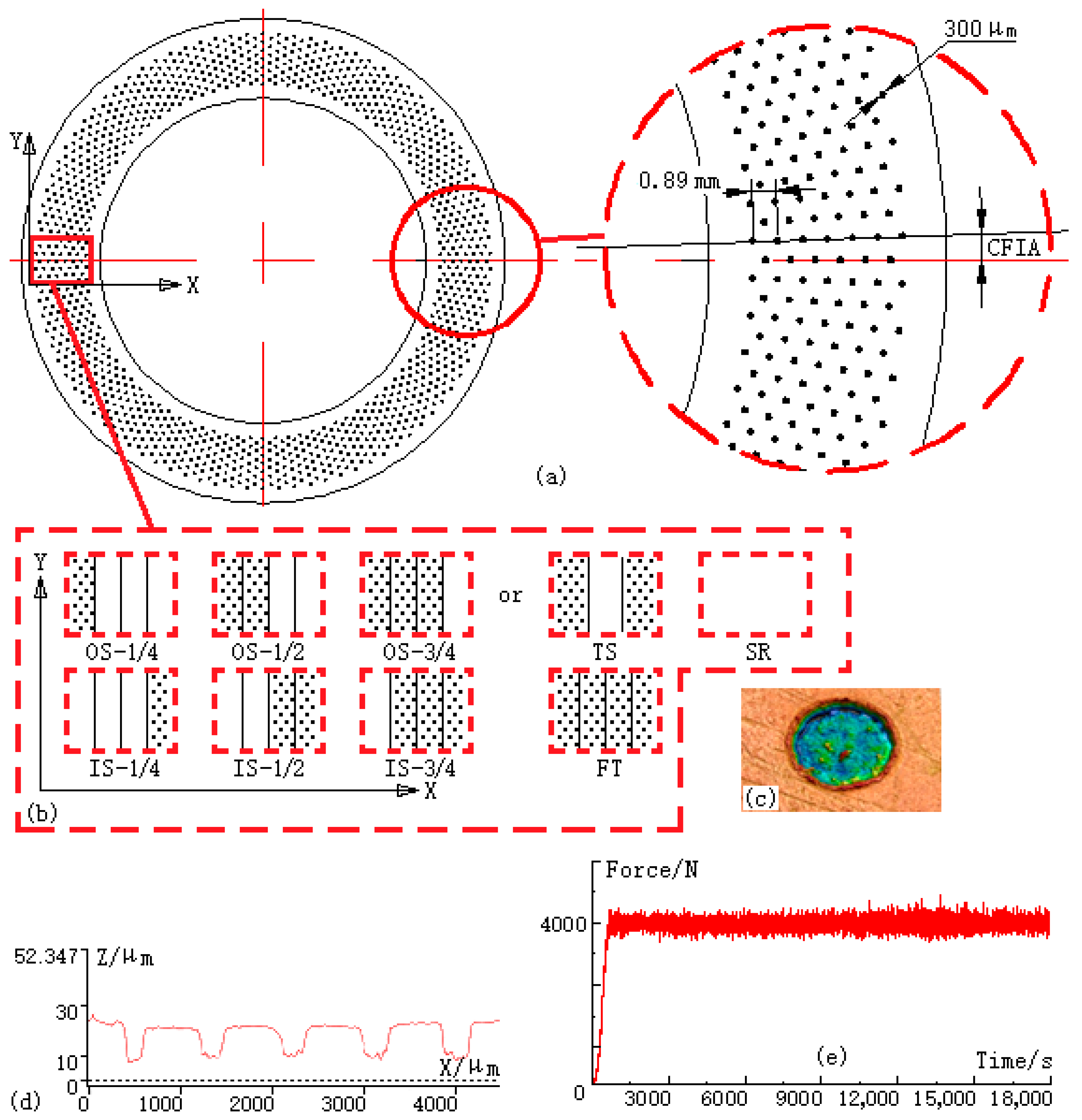
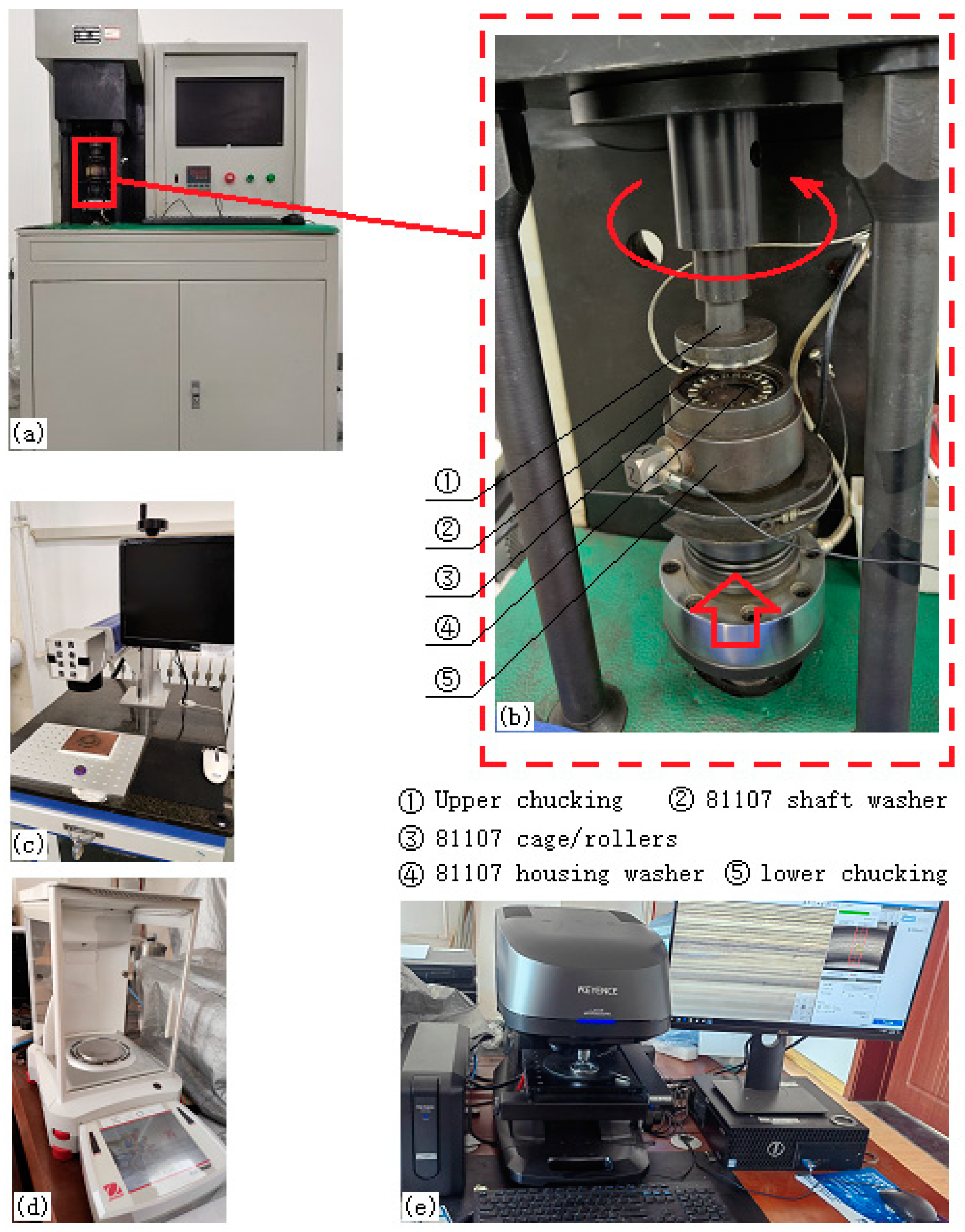
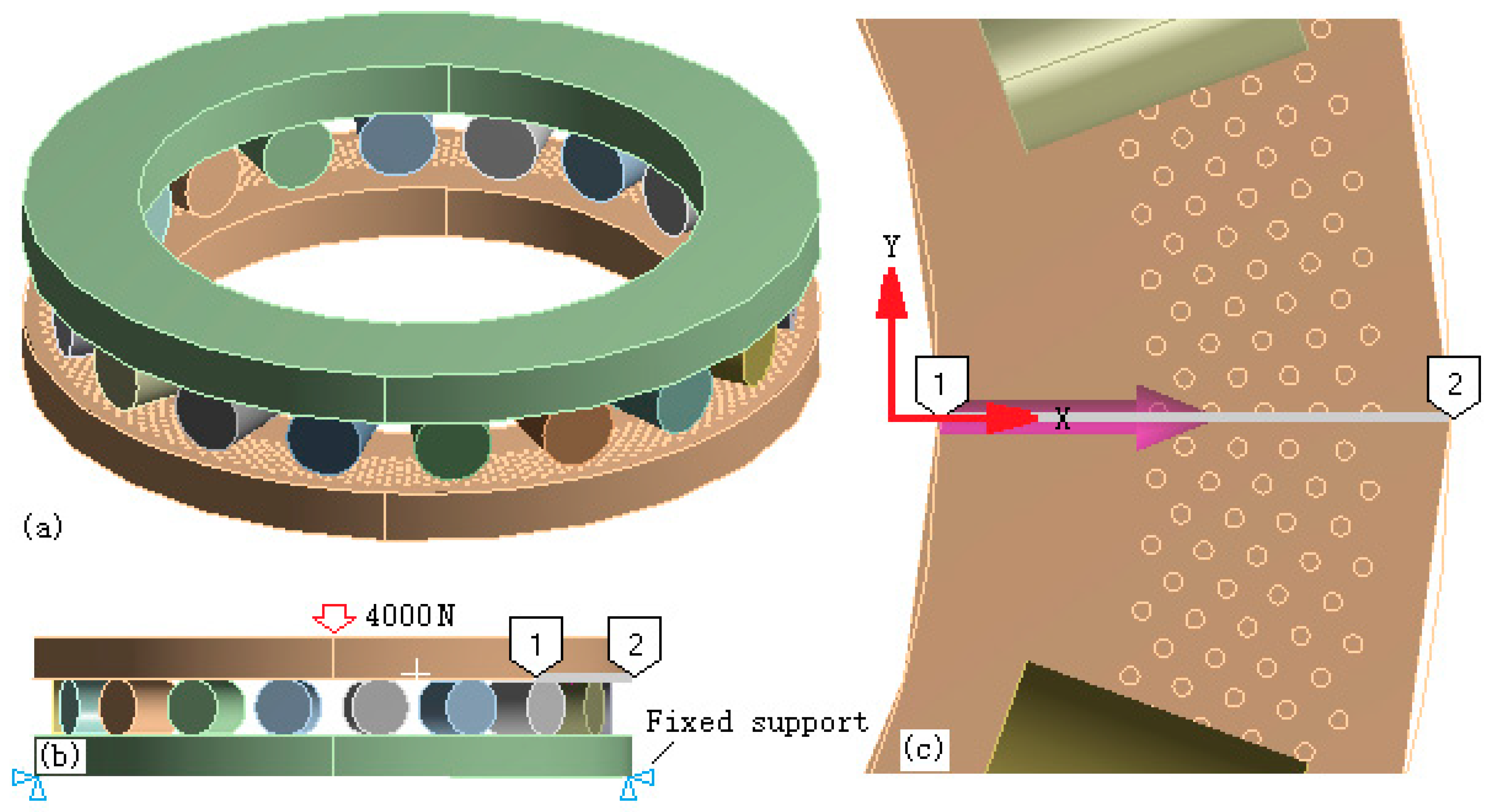
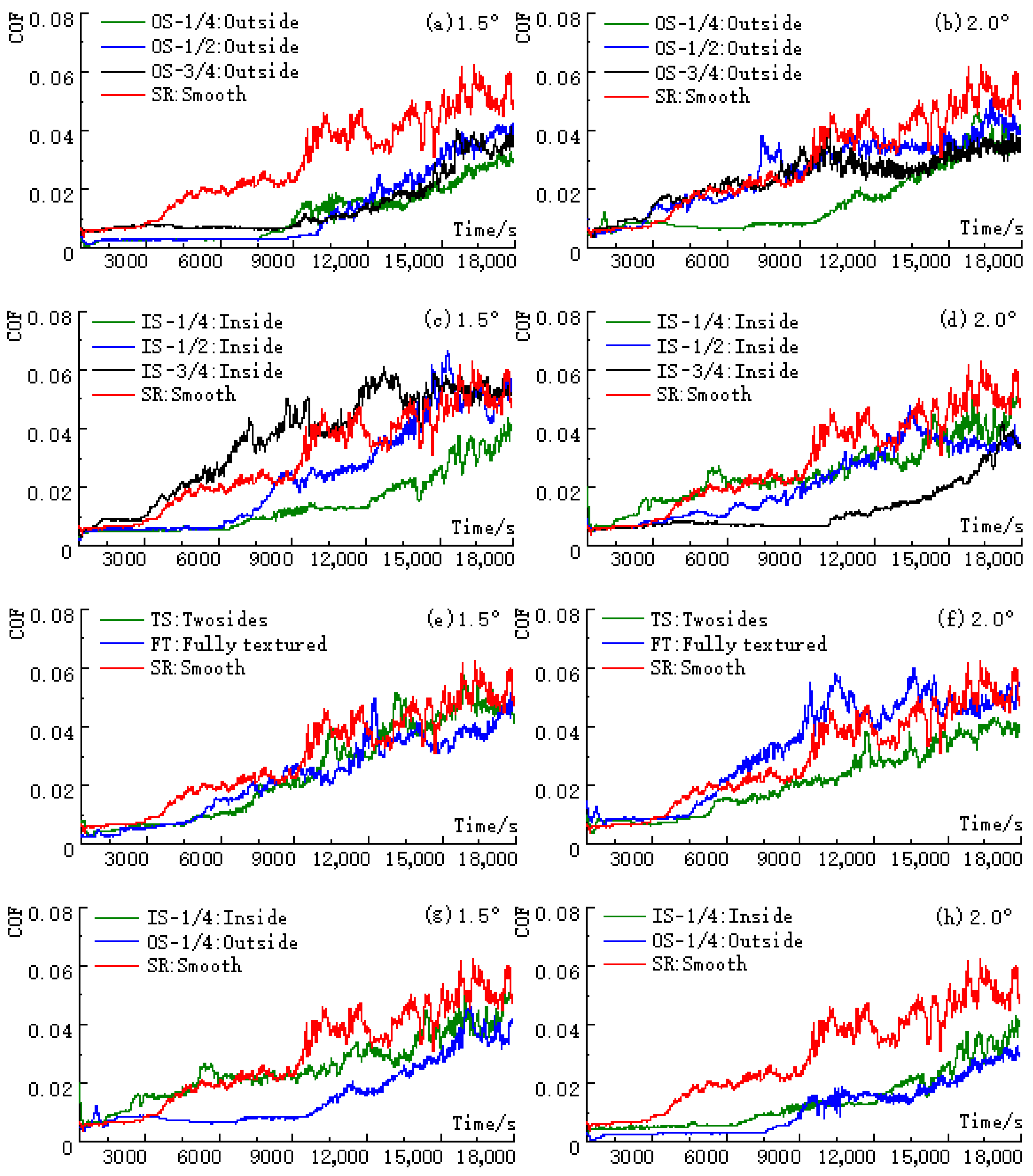

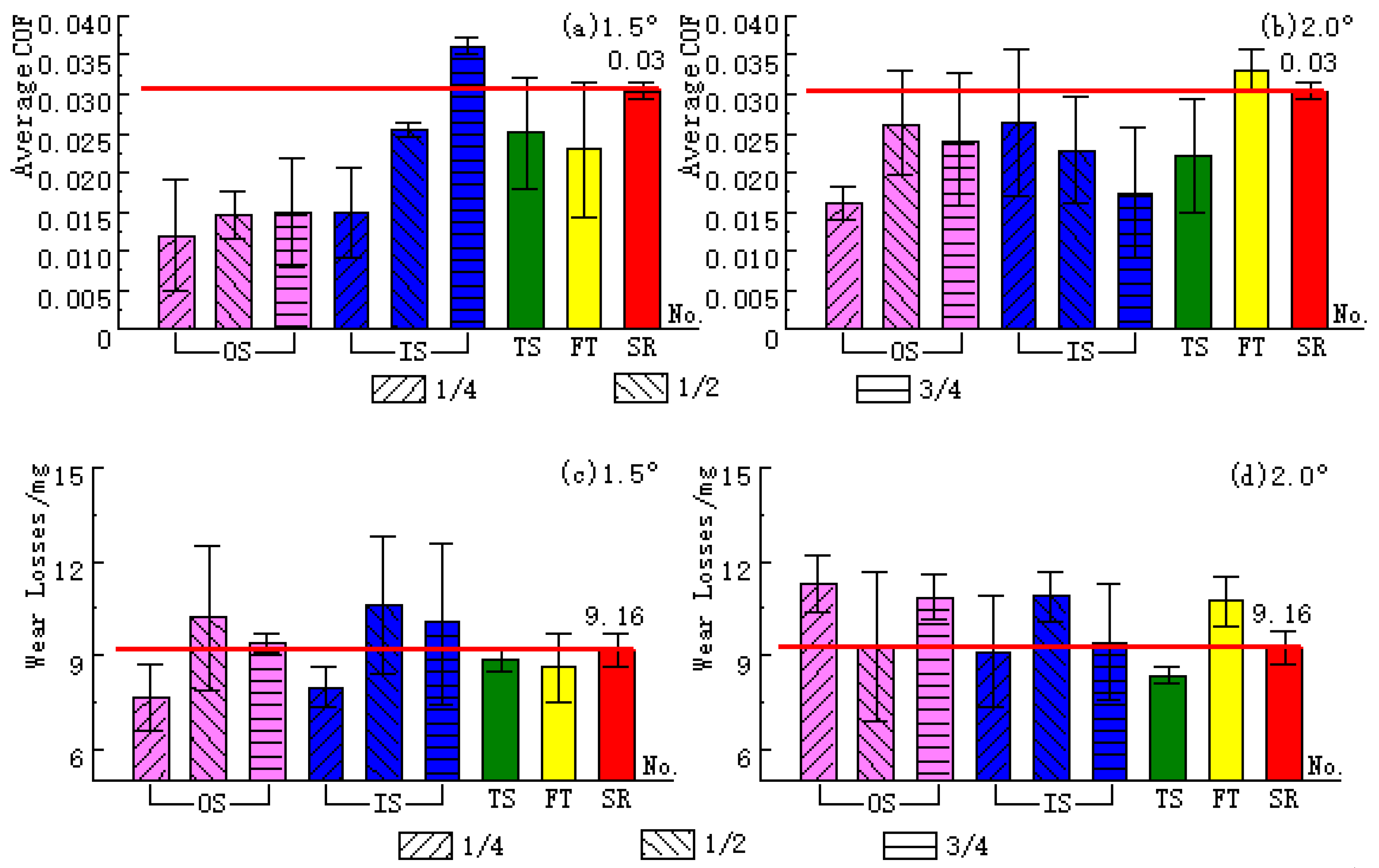
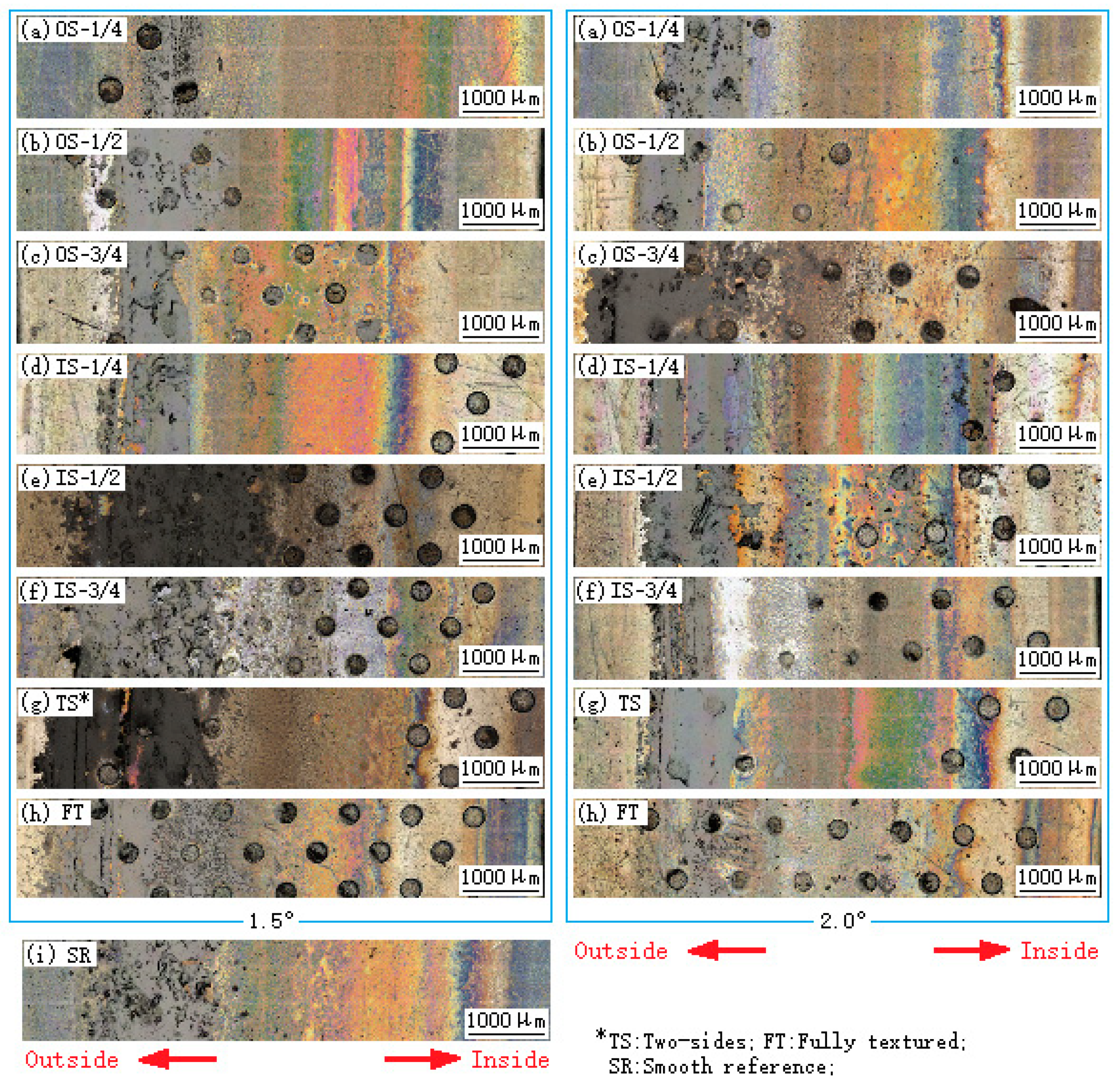
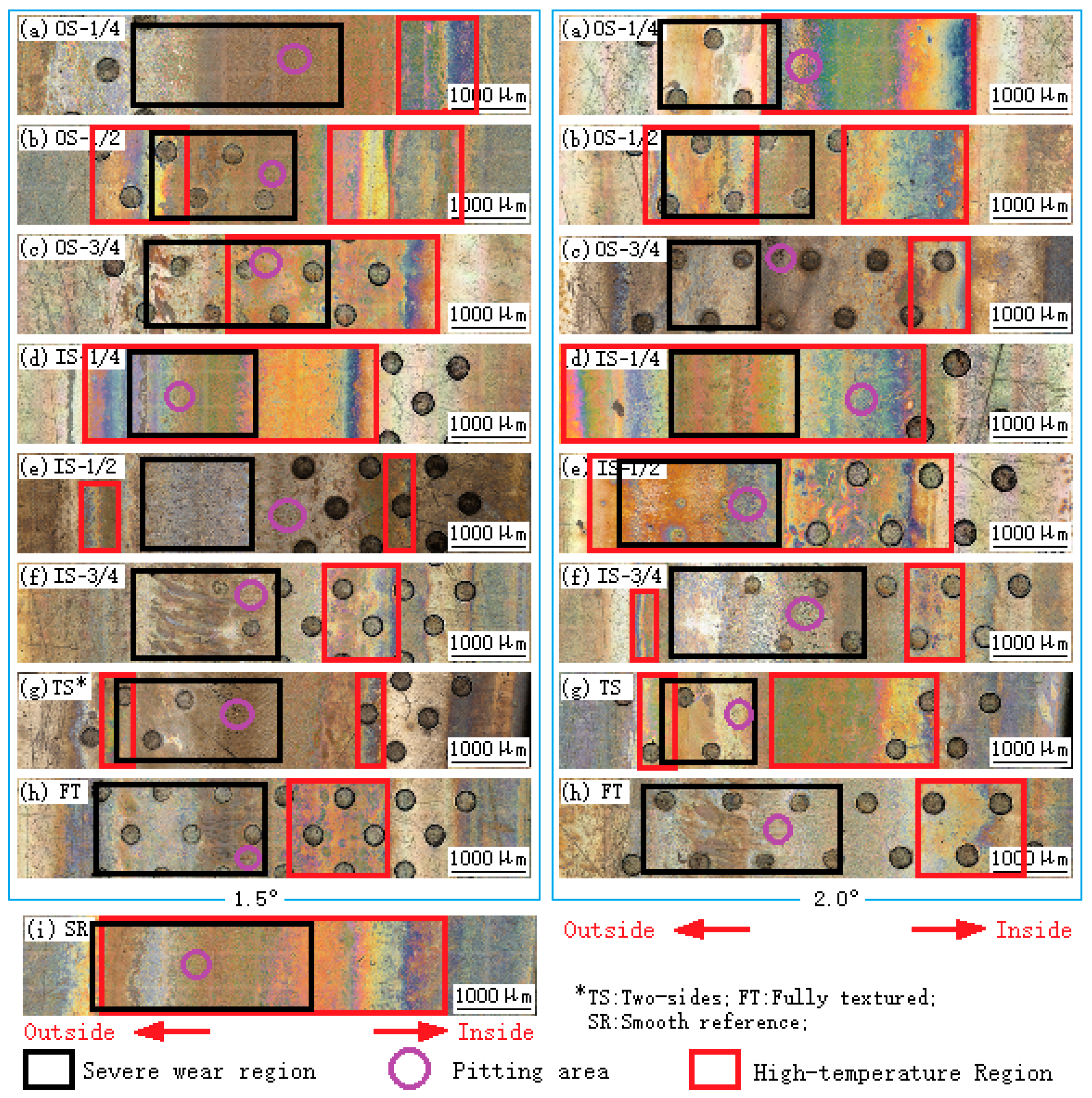
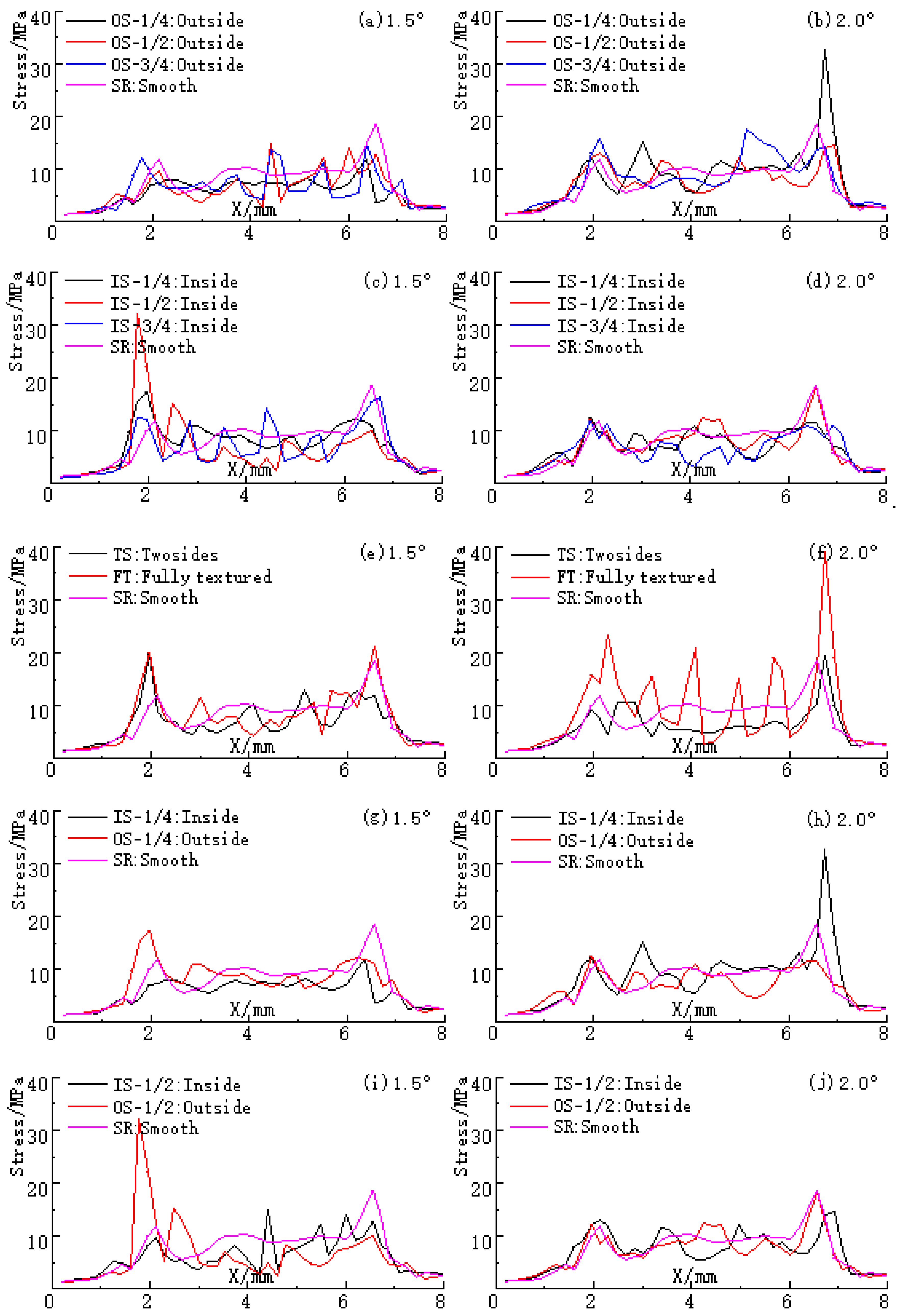
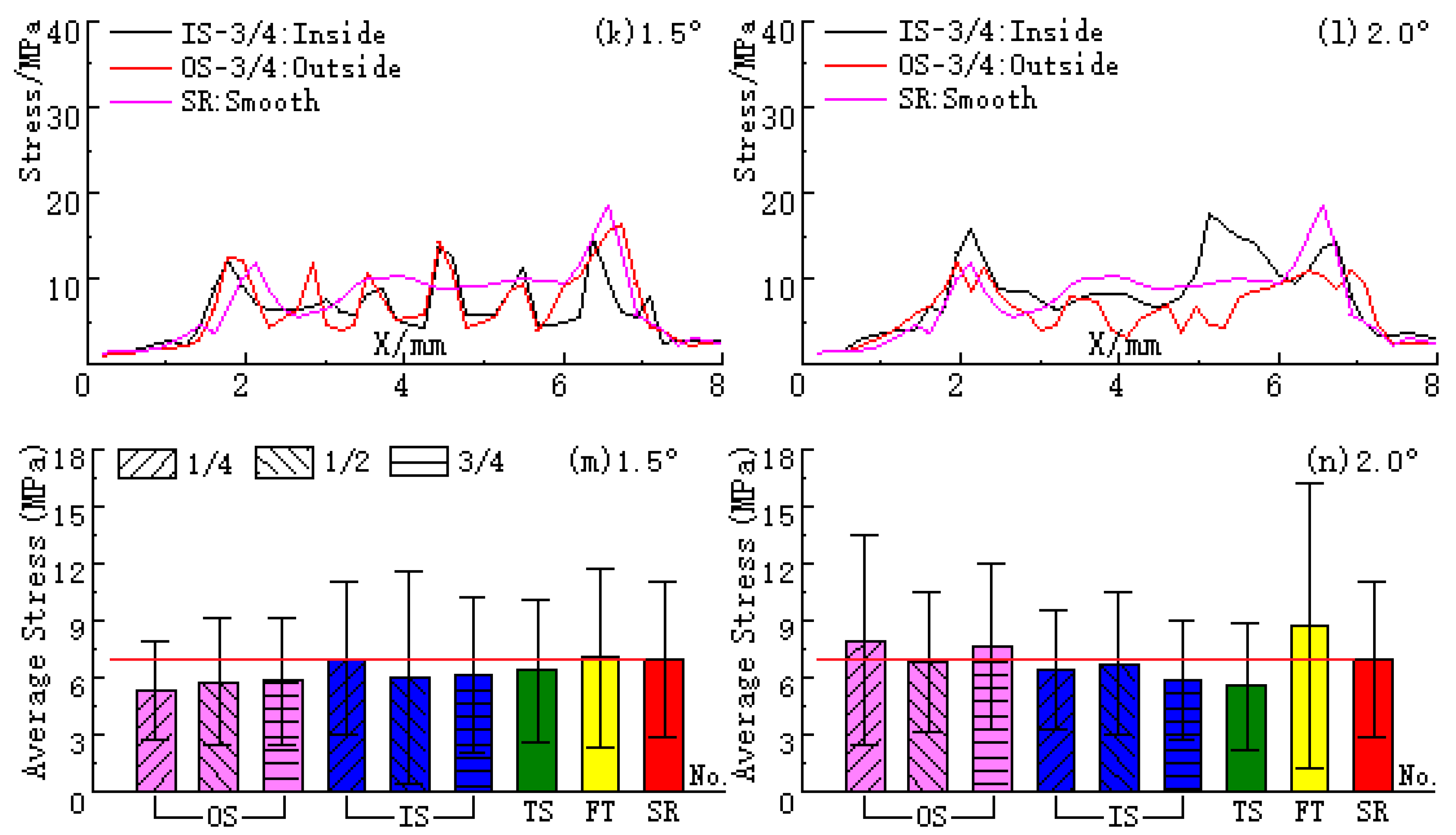
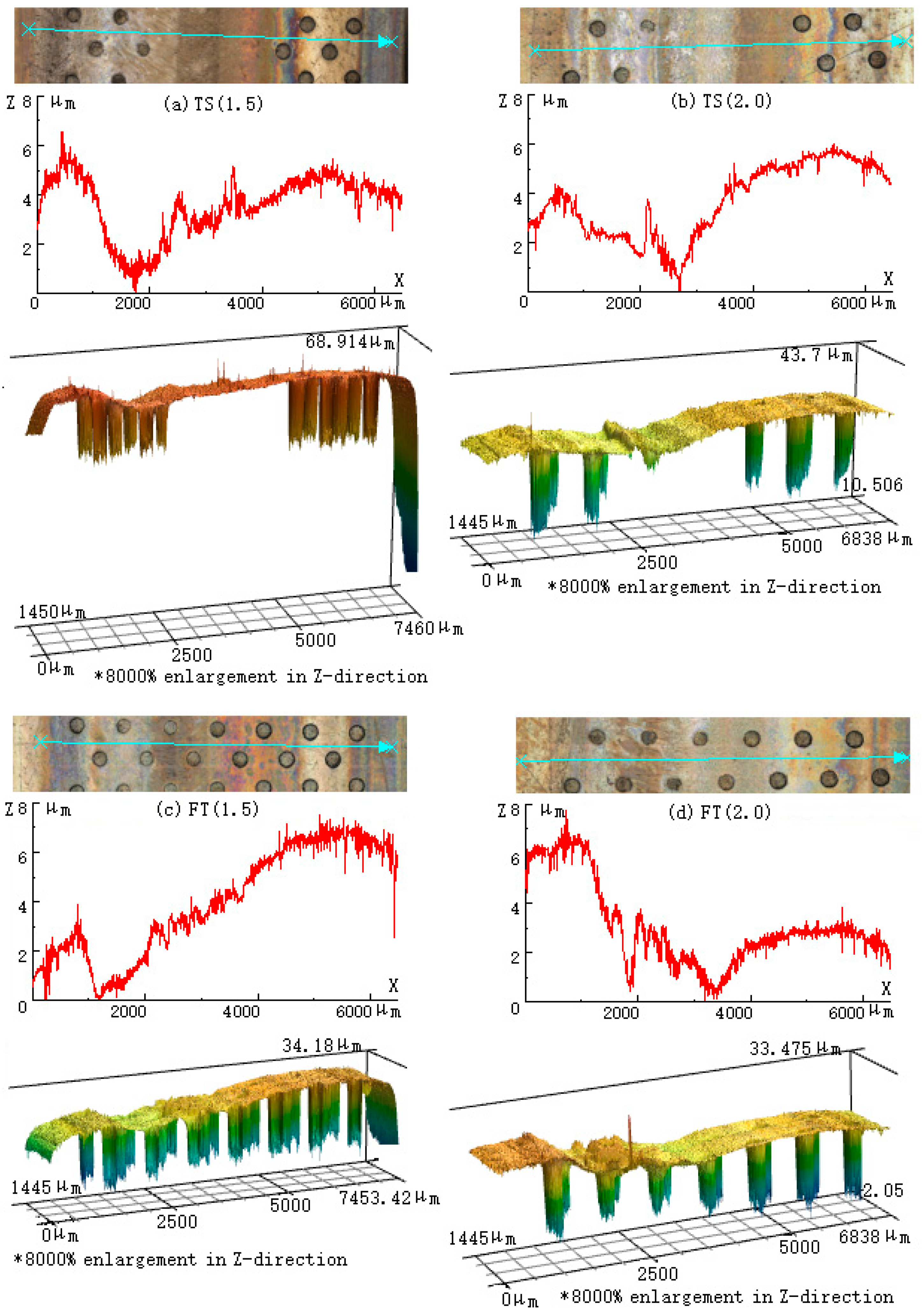
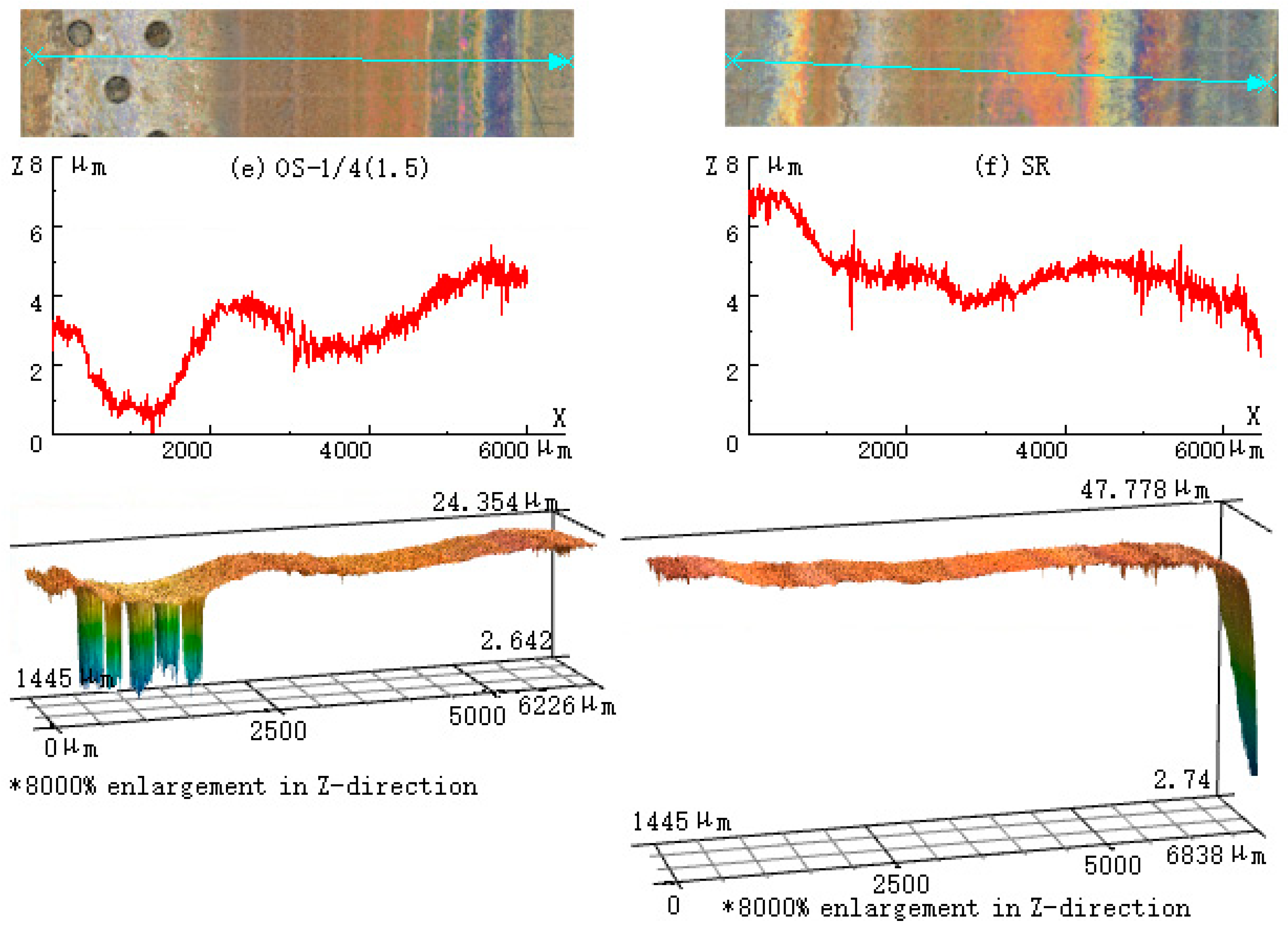
| Part | Dimension | Value |
|---|---|---|
| Shaft washer | Outer diameter (mm) | Φ 52 |
| Diameter of inner hole (mm) | Φ 35 | |
| Height (mm) | 3.5 | |
| Housing washer | Outer diameter (mm) | Φ 52 |
| Diameter of inner hole (mm) | Φ 37 | |
| Height (mm) | 3.5 | |
| Rollers | Height (mm) | 5 |
| Diameter (mm) | Φ 5 | |
| Number | 18 | |
| Basic rated static/dynamic load (N) | 101,000/39,000 | |
| Ultimate fatigue load (N) | 9500 | |
| Group No. | Pattern | CFIA (°) | Area Density (%) |
|---|---|---|---|
| OS-1/4 |  | 1.5/2.0 | 2.19/1.64 |
| OS-1/2 |  | 1.5/2.0 | 4.38/3.29 |
| OS-3/4 |  | 1.5/2.0 | 6.57/4.93 |
| IS-1/4 |  | 1.5/2.0 | 2.19/1.64 |
| IS-1/2 |  | 1.5/2.0 | 4.38/3.29 |
| IS-3/4 |  | 1.5/2.0 | 6.57/4.93 |
| TS |  | 1.5/2.0 | 5.80/3.29 |
| FT |  | 1.5/2.0 | 9.49/8.76 |
| SR | - | - | - |
| Item | Value |
|---|---|
| Wave length (μm) | 1064 |
| Scanning speed (mm/s) | 100 |
| Maximum laser power (W) | 30 |
| Laser power output ratio (%) | 30 |
| Frequency (Hz) | 72 |
Disclaimer/Publisher’s Note: The statements, opinions and data contained in all publications are solely those of the individual author(s) and contributor(s) and not of MDPI and/or the editor(s). MDPI and/or the editor(s) disclaim responsibility for any injury to people or property resulting from any ideas, methods, instructions or products referred to in the content. |
© 2023 by the authors. Licensee MDPI, Basel, Switzerland. This article is an open access article distributed under the terms and conditions of the Creative Commons Attribution (CC BY) license (https://creativecommons.org/licenses/by/4.0/).
Share and Cite
Chen, Y.; Long, R.; Jin, Z.; Zhao, C.; Wang, M. Influence of the Distribution of Pits on the Friction and Wear Performance of Textured Rolling Bearings under Starved Lubrication. Lubricants 2023, 11, 197. https://doi.org/10.3390/lubricants11050197
Chen Y, Long R, Jin Z, Zhao C, Wang M. Influence of the Distribution of Pits on the Friction and Wear Performance of Textured Rolling Bearings under Starved Lubrication. Lubricants. 2023; 11(5):197. https://doi.org/10.3390/lubricants11050197
Chicago/Turabian StyleChen, Yazhe, Risheng Long, Zhihao Jin, Chen Zhao, and Ming Wang. 2023. "Influence of the Distribution of Pits on the Friction and Wear Performance of Textured Rolling Bearings under Starved Lubrication" Lubricants 11, no. 5: 197. https://doi.org/10.3390/lubricants11050197
APA StyleChen, Y., Long, R., Jin, Z., Zhao, C., & Wang, M. (2023). Influence of the Distribution of Pits on the Friction and Wear Performance of Textured Rolling Bearings under Starved Lubrication. Lubricants, 11(5), 197. https://doi.org/10.3390/lubricants11050197







